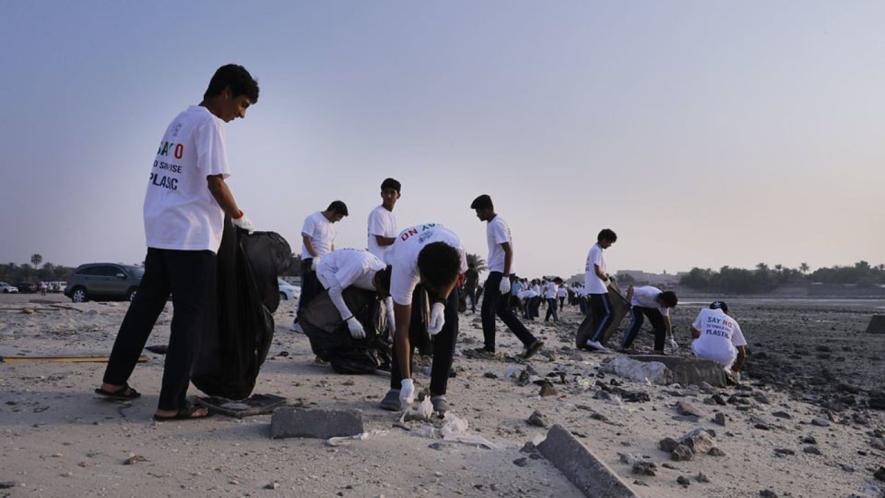The Bodies Beneath Swachh Bharat

Image Courtesy: Flickr
In the Indian imagination, the modern city is often equated with progress. Smart Cities, Swachh Bharat dashboards, LED-lit footpaths, and shiny Metro lines indicate development. Yet, beneath this polished surface lies a persistent and disturbing reality, Indian cities continue to be cleaned by people whose lives are devalued by birth.
Despite laws, schemes, and policy declarations, the work of cleaning sewers and septic tanks is still overwhelmingly carried out by Dalits, often through informal contracts, and often without protective gear. This is not an aberration. It is a structure.
The persistence of caste-based sanitation labour, especially in an era that claims to prioritise modernisation and inclusion, raises urgent questions. Why does this form of labour continue to be hereditary and hazardous? What explains the disconnect between legal abolition and material continuity? And what does this say about the way Indian urbanisation has been designed, financed, and imagined?
Persistence Despite Prohibition
Since the Prohibition of Employment as Manual Scavengers and their Rehabilitation Act came into force in December 2013, the State has repeatedly claimed progress. Yet, data reveals a different picture. Between 2019 and October 2024, the Ministry of Social Justice and Empowerment reported 419 deaths due to sewer and septic tank cleaning. This amounts to over 70 deaths per year.
However, civil society groups, such as the Safai Karamchari Andolan (SKA) and Dalit Adivasi Shakti Adhikar Manch (DASAM) record significantly higher numbers. DASAM alone documented 158 sanitation worker deaths in just 18 months between January 2024 and June 2025.
The discrepancy stems partly from semantics. The State distinguishes between 'manual scavenging' (removal of excreta from dry latrines) and 'hazardous cleaning of sewers', thereby technically avoiding violations of the law even when the work resembles banned practices. As a result, workers cleaning toxic waste with bare hands often do not fall under the category of 'manual scavengers' and hence are excluded from protection and compensation.
Furthermore, reporting mechanisms are inconsistent. For instance, the BMC (Brihanmumbai Municipal Corporation) in Mumbai has claimed zero sanitation worker deaths since 2017. But SKA has recorded 19 such deaths in Mumbai alone. In Delhi, official records showed no deaths in 2023, while independent documentation listed at least eight. Such denial has real effects: it delays compensation, erases accountability, and sustains the myth of progress.
Infrastructure Without Justice
Urban India’s commitment to sanitation is evident in financial terms. Since 2014, the Swachh Bharat Mission has spent over ₹62,000 crore, constructing more than 110 million toilets. Meanwhile, the Smart Cities Mission has promoted tech-driven solutions and citizen scorecards for cleanliness. But what remains missing in these schemes is a clear articulation of who does the cleaning
The NAMASTE scheme (National Action for Mechanised Sanitation Ecosystem), launched in 2022, aims to eliminate hazardous sanitation work through mechanisation. It received a total allocation of ₹360 crore for four years. As of mid-2025, about 91,000 sanitation workers had been profiled under this scheme. Yet only 45,871 received PPE (personal protective equipment) kits, 28,447 received health cards, and just 503 beneficiaries were given financial assistance to purchase sanitation equipment. This means less than 0.6% of identified workers accessed capital subsidy. Meanwhile, sewer deaths continue.
The declaration of over 3,300 cities as “Safai Mitra Surakshit Shehar” has not translated into measurable safety improvements. Many of these cities reported fatalities during the same period. This gap between declared policy and lived experience suggests that mechanisation is not simply a matter of budget but of political will, design compatibility, and infrastructural intent. Mechanised vehicles are sanctioned, but they are often not deployed. Technologies, like Bandicoot robots, exist but are piloted only in a few cities.
The lack of universal access to functional tools is compounded by design flaws in infrastructure. Many sewers are narrow, poorly maintained, or not built with machine access in mind. Some equipment remains unused because there is no operator training or technical maintenance support. This disconnects between capital expenditure and everyday usability undermines the promise of mechanisation.
Caste, Contract, and Informality
Sanitation labour is not only dangerous; it is structured through caste and informality. Most sanitation workers belong to the Scheduled Castes and Other Backward Classes. The 2024 data confirms that over 77% identified workers under the NAMASTE scheme came from historically marginalised communities.
Informality compounds vulnerability. Workers are frequently employed via contractors, with no job security or legal recognition. Many receive daily wages, have no insurance, and are unprotected by labour law. If they die on the job, employers often deny any formal relationship.
The role of the contractor is key. It allows municipal authorities to outsource risk. Even where machines are available, contract workers are asked to enter manholes manually. There have been cases of workers misclassified as security staff or temporary sweepers to evade liability. Families of the deceased often face immense hurdles in accessing compensation, which is mandated at ₹30 lakh by the Supreme Court.
This system persists because it is cheap and invisible. Manual labour costs less than mechanisation. Informal workers can be dismissed without legal proceedings. Their deaths do not show up in national databases because they are not formally employed. In effect, caste and contract combine to create a labour regime that is structurally disposable.
The invisibility of sanitation workers is sustained not only by State neglect but also by social apathy. Public discussion often celebrates the aesthetics of urban cleanliness while refusing to see or acknowledge the human cost. The metaphor of the city as a machine requires invisible hands to keep it running. But unlike machinery, these workers bleed and die.
Rural Blindness, Urban Bias
Much of the discourse on manual scavenging assumes it to be an urban problem. But recent reports, including those from the National Human Rights Commission and DASAM, highlight sanitation worker deaths in villages and peri-urban areas.
The rapid construction of septic tanks under the Swachh Bharat Mission in rural India has not been matched with faecal sludge management systems. As a result, new forms of hazardous work have emerged, especially in regions with weak municipal institutions. The data suggests that deaths occur in both private and public septic tanks, with rural families hiring sanitation workers informally.
This reveals a serious blind spot in policy thinking. Rural sanitation is treated as a matter of infrastructure, not labour. By contrast, urban sanitation is monitored through scorecards and dashboard metrics. The resulting neglect of rural cleaning labour has created an unregulated and dangerous ecosystem of informal service provision.
There is also a deeper irony. Swachh Bharat’s rural sanitation drive may have reduced open defecation, but it has also inadvertently expanded the market for manual cleaning. New toilets without corresponding waste treatment systems shift the burden of cleanliness onto marginalised bodies. The infrastructure is new. The logic of caste remains old.
Rethinking the Problem
The continued death of sanitation workers in sewers and septic tanks is not due to a lack of awareness or laws. It is the outcome of a system that structurally avoids accountability. Technological fixes are often presented as solutions. But machines do not deploy themselves. PPE kits do not guarantee use. And schemes do not dismantle caste.
Real reform requires structural change. That includes:
n Recognising all hazardous sanitation deaths as violations of law, regardless of classification
n Holding contractors and municipalities legally accountable
n Ending the outsourcing of sanitation work to unregistered firms
n Replacing daily-wage employment with formal municipal jobs
n Providing full access to compensation, equipment, and health services
n Ensuring that mechanisation includes technical training, maintenance support, and universal coverage
Equally important is the need to treat sanitation work as skilled, essential labour rather than hereditary punishment. Education and skill training programmes must be designed with the aim of creating alternate livelihoods. Until sanitation work becomes a matter of public responsibility and not private suffering, the cycle of risk and erasure will continue.
But perhaps, most importantly, we must question the vision of the city itself. If urban modernity is built on the denial of dignity to those who clean it, then what kind of progress is it? Until sanitation work is decoupled from caste and made truly safe, legal, and dignified, every Swachh Bharat milestone must be read not as an achievement, but as a warning.
The writer is an independent researcher and sociology educator. The views are personal.
References:
Dalit Adivasi Shakti Adhikar Manch (2025). "Sanitation Worker Deaths in India: A Two-Year Audit". New Delhi.
Government of India (2024). "Parliament Questions and Responses on Manual Scavenging". Ministry of Social Justice and Empowerment. https://sansad.in
Ministry of Housing and Urban Affairs (2023). "NAMASTE Scheme: Implementation Status and Budgetary Allocation". Press Information Bureau. https://pib.gov.in
National Commission for Safai Karamcharis (2023). "Annual Report on Sanitation Worker Fatalities". Government of India.
Safai Karamchari Andolan (2024). "Unseen, Uncounted: Deaths in the Sewer". SKA.
Scroll.in (2023). "Sanitation Deaths in Mumbai and the BMC's Zero Claim". https://scroll.in/article/1041036
The Wire (2024). "Deep Failure to Protect: Manual Scavenging and State Neglect". https://thewire.in/rights
WaterAid India (2022). "The Hidden World of Sanitation Workers". https://www.wateraid.org/in
Swachh Bharat Mission-Urban Newsletter, Vol 1, Issue 1, May 2015, Ministry of Urban Development, Government of India. https://www.swachhbharaturban.gov.in/writereaddata/SBM_newsletter.pdf
All data compiled from government and civil society sources between 2019 and 2025.
Get the latest reports & analysis with people's perspective on Protests, movements & deep analytical videos, discussions of the current affairs in your Telegram app. Subscribe to NewsClick's Telegram channel & get Real-Time updates on stories, as they get published on our website.
























